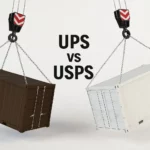Finding the cheapest way to ship a package is more critical than ever in today’s shipping cost-sensitive e-commerce landscape. In 2024, global e-commerce sales exceeded $4.12 trillion, a number expected to grow by nearly 16% in 2025 year and 11% in 2026. With this explosive growth and a super-competitive environment in many cases, businesses and individuals alike are seeking affordable and reliable shipping solutions to manage rising costs and meet consumer expectations.
For small businesses, shipping expenses can make up 10–15% of total operating costs, making it essential to select the most cost-effective (read “the cheapest”) shipping method. Meanwhile, 48% of online shoppers have abandoned their carts due to extra fees like shipping and tax. Finding the cheapest shipping methods can help you increase sales and streamline your operations.
In this guide, we’ll break down the cheapest way to ship a package, compare rates from leading providers like USPS, UPS, and FedEx, and provide actionable tips to reduce shipping costs.
For international shipping needs, check out our guide on the cheapest way to send a parcel abroad.
Cheapest Way to Ship a Very Small Package (< 1 lb)
If you’re shipping very lightweight items like accessories, documents, or small gadgets, USPS Ground Advantage usually offers the cheapest way to ship a small package. The service is affordable, reliable, and available nationwide.
0.25, 0.5, and 1 lb Packages
- USPS Ground Advantage is generally the most affordable for light packages under 1 lb, though it may take a few days longer than premium options.
- UPS Ground offers slightly higher rates but sometimes faster delivery—ideal if speed is important for your business or customer.
- FedEx Ground is reliable, though often more expensive than USPS or UPS for this weight range.
If you want to save, OrderCup provides discounts up to 88% with USPS, 80% with UPS, and 75% with FedEx, making it easier to choose a shipping method that balances both cost and delivery time.
Below is a comparison of relative cost tiers and estimated delivery times for shipping packages weighing less than 1 lb from Los Angeles, CA to New York City, NY. The dollar signs ($ = cheapest, $$$$$ = most expensive) represent general price ranges, not exact rates. Actual shipping costs can vary depending on multiple factors such as package dimensions, weight, shipping distance, service type, and volume of shipments.
Note: This format applies to all comparative tables in the article, offering a high-level view of affordability and speed across major carriers.
| Service | Relative Cost (0.25 lb) | Relative Cost (0.50 lb) | Relative Cost (< 1 lb) | Estimated Delivery Time |
| USPS Ground Advantage | $ | $ | $ | 5 business days |
| UPS Ground | $$ | $$ | $$ | 5 business days |
| FedEx Ground | $$$ | $$$ | $$$ | 5 business days |
Cheapest Way to Ship a Small Package (< 5 lbs)
For businesses regularly shipping small items, keeping costs low is crucial. Packages under 5 lbs are easier and cheapest to ship, especially when leveraging efficient delivery methods.
For items under 5 lbs, using providers like USPS, UPS, or FedEx is typically the cheapest way to ship a package.
1, 2, and 5 lbs Packages
- USPS Ground Advantage remains one of the cheapest options for lightweight items.
- USPS Priority Mail offers faster delivery—often 1–3 days—for slightly higher cost, making it a solid choice when speed matters.
- UPS Ground is competitively priced and can be a great alternative for slightly larger or more urgent packages.
- FedEx Ground works well for certain regions but may be pricier compared to USPS or UPS.
When using OrderCup, shipping is consistently cheaper than retail pricing. Plus, UPS Ground through OrderCup excludes fuel and remote area surcharges, making it even more cost-efficient.
| Service | Relative Cost (1 lb) | Relative Cost (2 lbs) | Relative Cost (5 lbs) | Estimated Delivery Time |
| USPS Ground Advantage | $ | $ | $ | 5 business days |
| USPS Priority Mail | $$ | $$ | $$ | 3 business days |
| UPS Ground | $$$ | $$$ | $$$ | 5 business days |
| FedEx Ground | $$$$ | $$$$ | $$$$ | 5 business days |
Cheapest Way to Ship a Medium Package (< 10 lbs)
For medium-sized packages weighing between 5 and 10 lbs, finding an affordable and reliable shipping service is essential. Carriers like USPS, UPS, and FedEx offer competitive rates for this weight category, with ground services typically being the most cost-effective option. Businesses shipping in this range can benefit from flat-rate boxes or discounted volume-based pricing.
5, 7, and 10 lbs Packages
- USPS Priority Mail is ideal if you want 2–3 day delivery at a reasonable rate, especially with flat-rate box options.
- UPS Ground is often slightly more expensive but delivers strong reliability and extensive tracking features.
- FedEx Ground is excellent for larger medium-weight shipments, particularly for commercial deliveries.
Shipping through OrderCup helps you tap into large-volume discounts, reducing the total shipping costs regardless of carrier choice.
| Service | Relative Cost (5 lbs) | Relative Cost (7 lbs) | Relative Cost (10 lbs) | Estimated Delivery Time |
| USPS Priority Mail | $ | $ | $ | 3 business days |
| UPS Ground** | $$ | $$ | $$ | 5 business days |
| FedEx Ground | $$$ | $$$ | $$$ | 5 business days |
Cheapest Way to Ship a Large Package (> 10 lbs)
Large and heavy packages can significantly impact business budgets, especially for e-commerce companies fulfilling bulk orders. Choosing the cheapest way to ship a package over 10 lbs is vital for reducing costs without compromising on reliability.
Businesses can benefit by negotiating volume-based discounts with carriers like UPS and FedEx or using flat-rate services for predictable costs. OrderCup users enjoy up to 75% off with FedEx, 80% off with UPS, and 88% off with USPS, making even heavy shipments more manageable.
10+, 20+, and 50+ lbs Packages
- UPS Ground tends to offer the most consistent rates and reliability for heavy parcels
- FedEx Ground becomes increasingly cost-effective as the package weight increases, especially when leveraging high-volume discounts.
- USPS Priority Mail can be a good option for certain sizes, especially when flat-rate shipping is applicable.
Delivery timeframes are also included to help weigh cost against speed. All data reflects typical OrderCup-discounted rates and may vary depending on package dimensions, weight, shipping volume, and seasonal factors.
| Service | Relative Cost (10 lbs) | Relative Cost (20 lbs) | Relative Cost (50 lbs) | Estimated Delivery Time |
| FedEx Ground | $$$ | $$$ | $ | 5 business days |
| UPS Ground | $$ | $$ | $$ | 5 business days |
| USPS Priority Mail | $ | $ | $$$ | 3 business days |
Cheapest Way to Ship a Package Depending on Delivery Speed
When speed matters, it’s still possible to find the cheapest way to ship a package without overspending. Next-day or 2-3 day delivery speeds are common in e-commerce, and finding affordable options for these timeframes can help meet customer expectations without eroding profit margins. The Rate Calculator within OrderCup allows you to search for the least expensive shipping option based on a class of shipping, such as Express shipping or Expedited Shipping, helping businesses optimize their shipping costs.
By balancing urgency and cost, services like USPS Priority Mail Express or FedEx 2-Day, or UPS 3Day Select provide reliable shipping for fast timelines without breaking the bank.
Next Day Delivery
For urgent deliveries, next-day options are available but can be costly.
- USPS Priority Mail Express offers overnight service with early delivery, great for urgent but lightweight packages.
- UPS Next Day Air Saver and FedEx Standard Overnight provide fast, guaranteed delivery windows—ideal for business-critical shipments.
These are the fastest but most expensive options—yet still cheaper with OrderCup’s steep discounts.
| Service | Relative Cost – Next Day (1 lbs) | Relative Cost – Next Day (10 lbs) | Relative Cost – Next Day (20 lbs) | Estimated Delivery Time |
| UPS Next Day Air Saver | $ | $ | $ | Next business day by 4:30 PM for business and 8 PM for residential deivery |
| FedEx Standard Overnight | $$ | $$ | $$ | Next business day by 4:30 PM for business and 8 PM for residential delivery |
| USPS Priority Mail Express | $$$ | $$$ | $$$ | 2 Day delivery by 6 PM |
2–3 Days Delivery
When you have more time, 2–3 day delivery is a cost-effective choice.
- USPS Priority Mail offers fast, affordable shipping—usually the cheapest way to mail a package in under three days.
- UPS 3-Day Select is reliable for coast-to-coast shipments.
- FedEx Express Saver is another dependable option, especially for commercial addresses.
OrderCup’s discounted rates across all providers ensure you’re always getting the cheapest shipping method possible for your delivery timeline.
| Service | 2–3 Days (1 lbs) | 2–3 Days (10 lbs) | 2–3 Days (20 lbs) | Estimated Delivery Time |
| USPS Priority Mail | $ | $ | $ | 1–3 business days |
| UPS 3-Day Select | $$ | $$ | $$ | 3 business days |
| FedEx Express Saver | $$$ | $$$ | $$$ | 3 business days |
Delivery Provider Tariff Calculator
Using shipping calculators can simplify the process for businesses managing high shipping volumes. Tools from Order Cup allow businesses to optimize their shipping strategies and find the cheapest way to ship a package based on precise package dimensions, weight, and destinations. Use the Compare Rates Calculator in Order Cup to instantly compare rates and choose the cheapest option from all carriers offered by FedEx, UPS, USPS, and others.
These tools allow you to input dimensions, weight, and exact origin/destination to get accurate quotes.
Factors Influencing Shipping Costs
Shipping costs vary based on several critical factors, and knowing these can help you find the cheapest way to ship a package while meeting your delivery needs. Below is a detailed explanation of what affects shipping prices:
- Weight of the Package: The weight of your package affects shipping costs, with carriers charging in weight increments (e.g., 1 lb, 5 lbs, 10 lbs). Lightweight packages under 1 lb are often cheapest with USPS First-Class Mail, while heavier packages may be more cost-effective with USPS Priority Mail Flat-Rate Boxes or UPS Ground.
- Dimensions of the Package: Large, lightweight packages are charged based on dimensional weight (DIM weight), which considers the package size rather than actual weight. Using compact, space-efficient packaging can help reduce costs.
- Shipping Distance: Most carriers use shipping zones to determine costs, with longer distances resulting in higher fees. Local shipping (Zone 1) is more affordable than long-distance shipping (Zone 8). For interstate shipments, regional options may offer the cheapest rates.
- Delivery Speed: Faster shipping options like next-day or 2-day delivery are more expensive. Slower services such as USPS Retail Ground or UPS SurePost are more budget-friendly but have longer delivery times.
- Additional Services: Features like tracking, insurance, and signature confirmation increase the total cost but are valuable for high-value or fragile shipments.
- Packaging Materials: Using carrier-provided packaging, such as USPS Flat-Rate Boxes, can save money since the box cost is included. If using your own box, keep it lightweight and appropriately sized to avoid DIM weight charges.
- Residential or business delivery: Most carriers (other than USPS) charge an additional fee for residential delivery.
Tips for Reducing Shipping Costs
Whether you’re running a business or shipping a gift to a loved one, these practical tips will help you find the cheapest shipping options while ensuring reliable delivery.
- Use Flat-Rate Boxes for Heavy Items: USPS Priority Mail Flat-Rate Boxes offer fixed pricing for packages up to 70 lbs, regardless of distance, making them ideal for dense and heavy items.
- Pack Efficiently: Optimize packaging by reducing box size and avoiding unnecessary materials. Use polymailers for lightweight items to minimize dimensional weight fees.
- Compare Rates Across Carriers: Use tools like the USPS Rate Calculator, UPS Shipping Calculator, and FedEx Rate Finder to compare prices and find the cheapest service.
- Leverage Regional and Zone-Based Shipping: Use services like USPS Regional Rate Boxes or FedEx Ground for shorter distances, which often provide lower rates within the same state or nearby regions.
- Consolidate Multiple Shipments: Ship one larger box instead of multiple smaller packages to reduce handling fees. Take advantage of multi-box shipping discounts when sending multiple packages to the same address.
- Negotiate Discounts with Carriers: Regular shippers should contact carriers like UPS or FedEx to negotiate discounted rates. Even small businesses can save by signing up for carrier accounts or using third-party platforms.
- Choose Slower Shipping Methods: For non-urgent deliveries, select slower services like USPS Retail Ground, FedEx SmartPost, or UPS SurePost for reliable yet more affordable shipping.
- Take Advantage of Free Carrier Pickups: Schedule free pickups with USPS or other carriers to save time and avoid drop-off location fees.
- Use Third-Party Platforms: Platforms like OrderCup, ShipStation, and Shippo compare rates from multiple carriers and offer discounts not available directly from carriers.
- Monitor Trends: Analyze shipping data regularly to identify cost-saving opportunities, such as underutilized discounts or inefficient packaging methods.
- Utilize USPS Priority Mail Cubic Pricing (if applicable): If your packages are small but dense, USPS Cubic Pricing can be one of the cheapest ways to ship a box, especially for short- to mid-distance deliveries. OrderCup automatically factors this in when calculating rates.
Finding the Cheapest Way to Ship a Package
Choosing an affordable, reliable shipping method is crucial for protecting profit margins and ensuring customer satisfaction. OrderCup simplifies shipping for businesses by offering discounted rates from USPS, UPS, and FedEx, in addition to providing you the capability to compare rates across configured carrier services. Its seamless integration with e-commerce platforms and shipping profiles and rules automates tasks like carrier service selection, label generation, tracking, and notifications.
Combine affordability with efficiency—use OrderCup to streamline your shipping and stay competitive.
FAQs: Cheapest Way to Ship a Package
Is it cheaper to ship in your own box?
Using your own box is cheaper for lightweight, compact packages (under 5 lbs), as carriers like USPS offer lower rates for custom sizes. For heavier or long-distance shipments, Flat-Rate Boxes may be more cost-effective. Compare both options to find the best deal.
Is it cheaper to ship a bag or box?
Bags are often cheaper than boxes for lightweight and non-fragile items because they reduce dimensional weight charges. Polymailers are a great choice for items like clothing or small accessories. However, if your item is fragile or requires extra protection, a box is safer. When choosing the cheapest way to mail a package, consider the item’s weight, fragility, and required packaging.
What is the cheapest delivery service for packages – USPS, UPS, or FedEx?
The cheapest delivery service depends on your package size, weight, and delivery speed.
- USPS is generally the cheapest for small and lightweight packages, particularly with First-Class Mail or Priority Mail.
- UPS Ground offers competitive rates for heavier items or long-distance shipments.
- FedEx Ground is another cost-effective option for heavier packages but can be slightly more expensive than UPS for certain distances.
Is it cheaper to ship by weight or box size?
The cost-effectiveness of shipping by weight or box size depends on the carrier and service. Carriers often use dimensional weight (DIM weight) for large packages, charging based on size rather than actual weight. If your package is small but heavy, a service like USPS Flat-Rate Boxes may offer better value. Conversely, for lightweight and large packages, reducing the dimensions is key to keeping costs low.
OrderCup negotiated a higher dimensional factor than the normal factor, which is 169, thus reducing your shipping cost for larger boxes.
Is it cheaper to ship multiple boxes or one big box?
Shipping one large box is often cheaper than sending multiple smaller boxes due to fewer handling and delivery fees. However, this depends on the combined weight and dimensions of the smaller boxes. If consolidating items into one box leads to excessive size or weight, it may result in higher dimensional weight charges.
Another factor to consider is that both UPS and FedEx support multibox shipment which offers a discount for multiple boxes that are part of one shipment shipping to the same address. Always compare both options using shipping calculators to find the cheapest shipping service for your needs.




